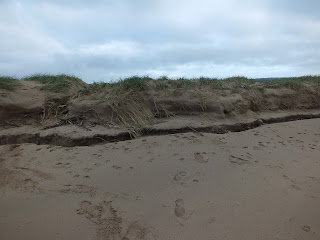I then walked the stretch of beach from the end of the grazing fields to the "Nose", sadly a lot of plastic litter has been dropped on the last few tides, as well as a few more Portuguese Man O' War.
 |
| A few Portuguese Man O' War still washing up |
Storm Brian, left its mark with a lot of erosion of the dune face, the photograph shows an area we used as access to drive down on to the beach, its a long drop now!
The remains of a small shark, possibly Small Spotted Catshark, looked like discarded bycatch
Some prep' work for a ringing session on Monday morning, will hopefully make setting up easier!, a male Sparrowhawk checked out the ringing ride approvingly, just come back on Monday!!
 |
| Through the van window male Sparrowhawk |
The grazier was taking the cattle off for routine TB testing, he asked if I could help for a few minutes, 2'5hrs later we all left.... herding cattle is a bit like herding cats, or frogs or any animal that decides it doesn't want to go through a gate and on to a lorry....
All I can say is ..Wednesday volunteers we have quite a few jobs to do, (there's a list) as a result of wayward cattle and cattle lorries!
Oh and I smell of silage and cattle cake?













